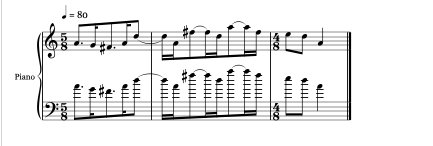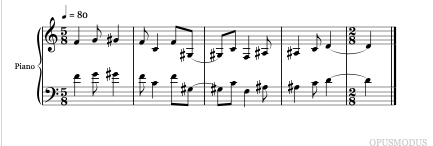-
Posts
77 -
Joined
-
Last visited
Content Type
Forums
Events
Store
Video Gallery
Posts posted by TomTolleson
-
-
I'm unsure as to how to post images inline so I hope this will make sense.
Pitch/melody inversion is interesting to me. To try that out, I'm going to take a simple line from Beethoven (pic 1). Using a negative melody, I invert around the tonic to be the following (pic2).
The difference in OMN is this:
(setf pitches '(a4 g4 fs4 a4 d5 a4 fs5 d5 a5 fs5 e5 d5)) (setf lengths '(e. s e. s e. s e. s e. s e e q))to this:
(setf lengths '(q e q e q e q e q e q e h)) (setf pitches '(f4 g4 gs4 f4 c4 f4 gs3 c4 f3 as3 as3 c4 d4))If I try the pitch inverse function described above, I start with this:
(pitch-invert '(a4 g4 fs4 a4 d5 a4 fs5 d5 a5 fs5 e5 d5))and I get this:
(a4 b4 c5 a4 e4 a4 c4 e4 a3 c4 d4 e4)Which is a bit different probably because I did my manual job incorrectly. However, it's a happy mistake which I will keep because I like it better!
 Having said that I do think the pitch-inverse is what you're looking for and a very cool compositional tool to have in Opusmodus!
Having said that I do think the pitch-inverse is what you're looking for and a very cool compositional tool to have in Opusmodus!
-
VMWare is a bit more tricky for me being on an AMD rather than Intel (which Mac uses). Latency was severe.
My workaround is just to remote in to my old mac and it seems to be working much better.
-
Curious about the file formats for import. I'm seeing "txt" but I'm wondering if formats that are output by, say Python or R can be used.
Just tested and was able to load a .csv but not a .feather or .rds file.Pulling in a dataframe and building a composition off that data will be an interesting experiment.
-
Thank you for the help everyone! These are great for my section on serialism.
I've switched my focus to serialism and neural networks (I found an example that generates content from simple Irish Folk songs in .mid files). My focus is on the ever-changing relationship that composers have with rules and procedures.
Tom
-
Hello,
I'm making a presentation on 12-tone composition in an educational context. While my focus is on a 12-tone map (including OMN and OpusModus code) I want to begin with some more simple examples e.g. a Canon, a Fugue, first second and third species counterpoint.
While I can create a canon, counterpoint and a fugue myself with a bit of time, it would be much less time-consuming for me if I were able to use existing examples. Is there an existing library of OMN examples of these types of compositions?
If not, I'm happy to post mine once I'm done.
Tom -
Thanks Janusz!
-
On 10/17/2014 at 5:53 PM, Stephane Boussuge said:
(setf clamuteplay (gen-trim size '(1 1 1 1 1 1 1 1 0 0 0 0 1 1 1 1 1 1 1 1 0 0))) (setf vnmuteplay (gen-trim size '(0 0 1 1 1 1 1 1 1 1 1 1 0 0 0 0 1 1 1 1 1 1))) (setf vamuteplay (gen-trim size '(0 0 0 0 0 0 0 0 1 1 1 1 1 1 1 1 0 0 0 0 1 1))) (setf vcmuteplay (gen-trim size '(0 0 0 0 1 1 1 1 1 1 1 1 1 1 1 1 0 0 0 0 0 0)))
Thanks, Stephane. This is a great example to work from. I've not created a piece with multiple parts exclusively in Opus Modus yet so this is a good starting point.
I received an error with an undefined function. Is that due to a version error or is there a function I need to build and reference as a separate file? Or perhaps its something else. Here's the error I received when I evaluated the file:
Quote? make-omn
? tonality-map
? ambitus
?
> Error: Undefined function length-rest-weight called with arguments ((8 1) ((q. e4 leg q gs4 leg a3 leg) (q. a4 leg q c5 leg eb5 leg) (q. bb4 marc+leg e e5 stacc fs4 stacc b4 leg bb4 leg) (e f5 mp stacc+marc bb4 stacc d5 stacc g5 stacc+marc a4 stacc c5 stacc+marc f4 stacc) (e d5 mf stacc+marc d5 stacc c5 stacc q fs5 marc+leg e a4 leg e5 leg) (e g4 f stacc+marc d4 stacc e4 stacc q f4 marc+leg e fs4 leg c5 leg) (e eb5 f stacc+marc f4 stacc g4 stacc e4 stacc+marc f5 leg q g5 leg) (q. cs4 f leg q f4 leg a4 leg) (e cs5 mf stacc+marc gs4 stacc b4 stacc cs5 stacc+marc bb3 leg q g4 leg) (q. bb4 f leg q f4 leg d5 leg) (e d4 mf stacc+marc eb5 stacc g4 stacc d5 stacc+marc cs4 leg q c4 leg) (e cs5 f stacc+marc c5 stacc a4 stacc q g5 marc+leg e b4 leg fs5 leg) (e c4 f stacc+marc c5 stacc a4 stacc b4 stacc+marc gs4 stacc f4 stacc+marc eb4 stacc) (e cs5 f stacc+marc e5 stacc cs5 stacc fs5 stacc+marc g4 stacc cs5 stacc+marc f4 stacc) (e e4 f stacc+marc gs4 stacc cs5 stacc q e4 marc+leg e gs4 leg gs4 leg) (e d5 mf stacc+marc bb4 stacc bb4 stacc c5 stacc+marc e5 stacc f4 stacc+marc fs4 stacc) (q. fs5 f marc+leg e a4 stacc eb4 stacc f4 leg gs4 leg) (e eb4 mf stacc+marc bb4 stacc cs4 stacc d4 stacc+marc b3 stacc fs4 stacc+marc fs4 stacc) (e bb4 stacc+marc e4 stacc b4 stacc eb4 stacc+marc e4 stacc fs4 stacc+marc cs5 stacc) (q. a4 leg q bb4 leg b4 leg) ...)) .
> While executing: ccl::cheap-eval-in-environment, in process Listener-2(7).
> Type cmd-/ to continue, cmd-. to abort, cmd-\ for a list of available restarts.
> If continued: Retry applying length-rest-weight to ((8 1) ((q. e4 leg q gs4 leg a3 leg) (q. a4 leg q c5 leg eb5 leg) (q. bb4 marc+leg e e5 stacc fs4 stacc b4 leg bb4 leg) (e f5 mp stacc+marc bb4 stacc d5 stacc g5 stacc+marc a4 stacc c5 stacc+marc f4 stacc) (e d5 mf stacc+marc d5 stacc c5 stacc q fs5 marc+leg e a4 leg e5 leg) (e g4 f stacc+marc d4 stacc e4 stacc q f4 marc+leg e fs4 leg c5 leg) (e eb5 f stacc+marc f4 stacc g4 stacc e4 stacc+marc f5 leg q g5 leg) (q. cs4 f leg q f4 leg a4 leg) (e cs5 mf stacc+marc gs4 stacc b4 stacc cs5 stacc+marc bb3 leg q g4 leg) (q. bb4 f leg q f4 leg d5 leg) (e d4 mf stacc+marc eb5 stacc g4 stacc d5 stacc+marc cs4 leg q c4 leg) (e cs5 f stacc+marc c5 stacc a4 stacc q g5 marc+leg e b4 leg fs5 leg) (e c4 f stacc+marc c5 stacc a4 stacc b4 stacc+marc gs4 stacc f4 stacc+marc eb4 stacc) (e cs5 f stacc+marc e5 stacc cs5 stacc fs5 stacc+marc g4 stacc cs5 stacc+marc f4 stacc) (e e4 f stacc+marc gs4 stacc cs5 stacc q e4 marc+leg e gs4 leg gs4 leg) (e d5 mf stacc+marc bb4 stacc bb4 stacc c5 stacc+marc e5 stacc f4 stacc+marc fs4 stacc) (q. fs5 f marc+leg e a4 stacc eb4 stacc f4 leg gs4 leg) (e eb4 mf stacc+marc bb4 stacc cs4 stacc d4 stacc+marc b3 stacc fs4 stacc+marc fs4 stacc) (e bb4 stacc+marc e4 stacc b4 stacc eb4 stacc+marc e4 stacc fs4 stacc+marc cs5 stacc) (q. a4 leg q bb4 leg b4 leg) ...)).
> Type :? for other options.
-
Ah, ok. So the script is not a score and must be added to a score? Good to know. That might fix my problem with the evaluate and play.
One other thing I am noticing:
Opusmodus is crashing whenever the window for another application is brought to the front in OSX. This has only happened since I upgraded to 1.2.21003 two days ago. It did not happen before.
Any idea what that cause might be?
Thanks,
Tom -
Hello!
I'm using the Version 1.2.21003.
After I "evaluate and play" a score in a Workspace, all other score evaluate and play the first score even if I remove the file. For example if I have:
Score A
Score B
and I evaluate and play Score A, when I evaluate and play Score B it plays Score A. If I remove score A, and evaluate and play score B it will play Score A (even though Score A is no longer there). If I remove all scores and evaluate and play in a blank screen, it will play score A.
Additionally, after evaluating and playing multiple times, Opus Modus will cease to be able to evaluate and play anything. It gives me the following error:
? compile-score nil
> Error: Too few arguments in call to #<Compiled-function serialize-scores #x3000015A629F>:
> 0 arguments provided, at least 1 required.
> While executing: serialize-scores, in process Listener-1(6).
> Type cmd-. to abort, cmd-\ for a list of available restarts.
> Type :? for other options.
1 >Once this occurs, it will be the same for all scores.
Any idea what's happening? Thanks,
T -
Thanks, Stephane!
-
Hello!
I'm very interested in the Euclidean Generator but not sure how to use it. I see a video mentioned by Stephane here:
But I could not find it in the link:
http://algorithmicmusiccomposer.blogspot.fr/
Is this video still available? I would love to see it.
Thanks!
Tom
-
I'll look into the tonality-map function. Good to know about the score parameters as I will be outputting this as a score as well.
Thanks!
Tom
-
Ah! This answers my question as well.
Let me further this by asking - if we want to alter the notes rather than just the notation, would key-signature-length be the advised approach?
(key-signature-length '((g maj 8/4) (e maj 6/4)))
If so, does this apply to the entire score or can it apply to individual instruments?
Thanks,
Tom
-
Thanks for the quick response, Stephane. This looks exciting. I can't wait to get home from work and try this out. ;-)
Regards,
Tom
-
I'm wondering if a series of pitches generated by white noise could be made to conform to a scale or harmonic progression in a scale such as (setf chords (harmonic-progression prog.prep '(d4 messiaen-mode5))).
That is - if I have several parts generated algortihmically, can I conform those notes using a second function that will conform them to a harmonic progression?
Thanks,
T -
-
Hello,
I've looked through the the materials which are helpful but I have a project is like to get underway and I think a Skype training session would be of benefit to me.
I'd like to send over my request. Is there a preferred email I can send this to?
Regards,
Tom
-
Hello,
I have converted one of my scores to OMN. The sequence of pitches, velocity and length are all demonstrated explicitly
example - (q b3 e -s b2b2 gs2 as2 a3 g2g2 g2 e2 -e)
I would like to take the sequence and convert it to the most appropriate function. I'm assuming this would take a step of analysis.
That is, instead of Function > Sequence, I want to perform Sequence> Analysis > map to a Function. Then I could eliminate the explicit OMN sequences and have a score that is (mostly) functions.
I'm not sure if this is possible, as it seems incredibly difficult to perform without manual data transformation. However, I'm curious if anyone else has attempted this sort of process?
Regards,
Tom
-
Hi Stephane,
Thank you! It worked perfectly.
Regards,
Tom
-
Hi Stephen,
Thank you for your response. I have one question - where in the interface would I find the action to convert to OMN? I've selected the file and right-clicked but did not see the option in the menu.
Thank you,
Tom
-
Hello,
I'm a new user and wondering if there is a recommended method to input and convert a score to OpusModus.
I have a score I've written in 4 parts each part represented in its own file in both MusicXML and MIDI. My goal is to import (either the MIDI or MusicXML) and convert these to OMN so that I can modify them using functions.
I have been able to import them but I'm having difficulty converting them to OMN and I haven't been able to find this specific use case in any of the documentation.
Any best practice or advice is appreciated.
Regards,
Tom -
Thank you. I'll spend some time looking into the tutorials and be back in touch if I need to be.
Tom
-
Hello,
I've noticed that there are a lot of great video and text resources for learning Opusmodus. However, I find that I generally learn more with a comprehensive hands-on experience under the guidance of an instructor who can discuss my questions with me.
I live in New York City and have searched online for any local training or resources and haven't found anything. I'm posting this in case anyone on the forum might be able to point me in the right direction.
Thanks!
Tom




Microtonal notations
in Suggestions & Ideas
Posted
This is important stuff and I'm glad we, or rather OpusModus, has the microtonal notation now.
I'm taking a class on microtonal music now and having to create a lot of 5-limit and 7-limit lattices. It'd be cool to be able to visualize lattices in the IDE.